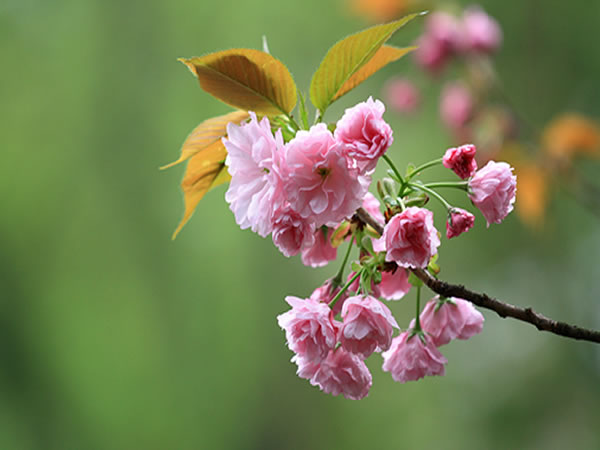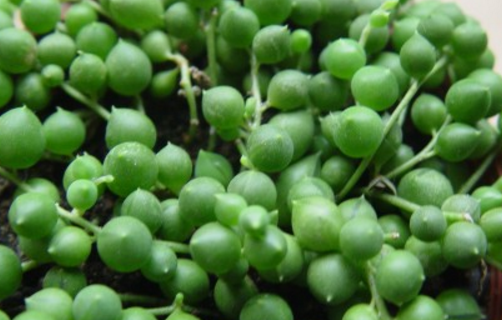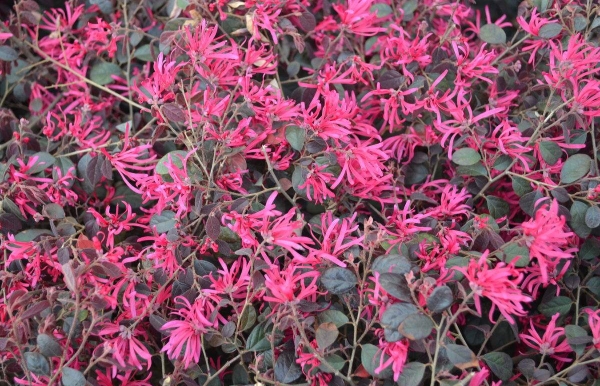What diseases and insect pests do Japanese cherry trees suffer from?
Root nodule disease
Root nodule disease occurs on or near the root neck of the ground, resulting in short plants and poor growth. When the disease occurs, the root of the plant produces nodules of different shapes, showing brown, rough epidermis and often accompanied by cracks.

Anthrax
In the early days of anthrax, round spots appear on its young leaves, and when these spots heal, they form perforations, and the leaves harden after June, while irregular rough spots appear on the leaves in brown color. In serious cases, it will cause a large number of fallen leaves, accompanied by withered buds.
Leaf perforation disease
Leaf perforation disease will have grayish brown round spots on the leaves, and then gradually expand into round spots about 3 cm in diameter, the specific characteristics of the disease spot is its clear boundary, the outside of the disease spot is purplish brown, while the inside of the disease spot is white-brown, with wheel lines, after the disease spot falls off, there is irregular perforation formation.
So, do you know how to solve it?
Common diseases and insect pests of Japanese late cherry in summer and their control
Japanese late cherry is a deciduous tree of the genus Sakura of Rosaceae, which is native to Japan and is widely cultivated in North and South China. Summer is the season of frequent occurrence of diseases and insect pests. Now the techniques of pest control are introduced as follows, for reference only. First, the risk of common pests. The common pests of Japanese evening cherry are: tea wing bug, peach aphid, carrot microtube aphid, apple aphid, Japanese woolly scale, wisteria gray scale, mulberry white shield scale, Korean brown ball scale, yellow diamondback moth, cotton belt roll moth, big pocket moth, tea bag moth, stick brown roll moth, brown edge green diamondback moth, double-toothed green diamondback moth, beautiful green diamondback moth, green diamondback moth, Lina diamondback moth, mulberry brown diamondback moth, peach neck longicorn beetle, dance poison moth, small green leafhopper and so on. Control methods: if it occurs, use 3000 times of 3% hypertonic phenoxarb EC to kill tea wing bugs, and 2000 times of imidacloprid wettable particles to kill peach aphids, carrot microtube aphids and apple aphids. Spraying Japanese paramecium, mulberry white shield scale and Korean brown ball scale with 3000 times of 3% hyperosmotic phenoxyvir EC or 2000 times of 10% imidacloprid wettable particles or 95% carbendazim emulsion and 1000 times of 20% scale EC; spraying diamondback moth, Plutella xylostella, Plutella xylostella Spray the yellow diamondback moth, brown green diamondback moth, double-toothed green diamondback moth, beautiful green diamondback moth, spotted green diamondback moth, Lina diamondback moth, mulberry brown spike moth, peach green longicorn beetle, peach green longicorn beetle and small green leafhopper with 7000 times of 20% diflubenzuron suspension and 1000 times of Bt emulsion. Second, common diseases. The common diseases of Japanese late cherry are root nodule, anthracnose and leaf perforation. During the onset of root nodule disease, the root of the plant shows nodule-like, different shapes, different sizes, brown to dark brown in color, and the thick epidermis is often cracked, which occurs on or near the root neck of the ground or where the rootstock connects with the scion. After the plant is damaged, it is often implied as poor development and dwarf of the plant. Prevention and treatment: dig up the damaged plant, rinse the soil, soak the root in 1% copper sulfate solution for 5 minutes, wash it, and then plant it; remove the tumor and apply 0.1% mercury solution to the wound before planting. In the early stage of anthracnose, there were round disease spots on the young leaves, and perforations could be formed after the disease spots healed. In June, the leaves hardened and the disease spots on the leaf surface were coarse and clumsy, which was brown alarm-like disease spots. When the disease is serious, it can cause a large number of fallen leaves and cause withered buds. Prevention and control method: spray alternately with 1000 times of 70% mancozeb wettable particles or 50% carbendazim wettable particles and 50% carbendazim wettable particles 1000 times, 3 times 4 times in a row, each time at a distance of 7 to 10 days. Leaf spray on the plant is prohibited during the disease period. When brown spot perforation disease occurs, there are grayish brown round dots at the beginning of the leaf, and with the growth of the disease, a round spot with a diameter of 3 cm is gradually formed, the gap of the disease spot is clear, the outside is purple-brown, the middle is white-brown, with wheel lines, and the disease spot is dead and out-dated to form a perforation of the police. Prevention and treatment: after the onset of the disease, 50% plus 1000 times of Ruinong liquid can be sprayed for prevention and treatment, once every 10 days, continuously spraying 3 times for 4 times, which can be useful to control the disease.
Control methods of common diseases and insect pests of Japanese late cherry Japanese late cherry is a deciduous tree of Rosaceae, which is native to Japan. It is widely cultivated in North and South China, and is an important early spring flowering tree species. Summer is the season of frequent occurrence of diseases and insect pests. The editor now introduces to you the prevention and control methods of common diseases and insect pests in Japanese evening cherry. Let's learn about them. First, the harm of common pests. The common pests of Japanese evening cherry are: tea wing bug, peach aphid, carrot microtube aphid, apple aphid, Japanese woolly scale, wisteria gray scale, mulberry white shield scale, Korean brown ball scale, yellow diamondback moth, cotton belt roll moth, large bag moth, tea bag moth, stick brown roll moth, brown edge green diamondback moth, double-toothed green diamondback moth, beautiful green diamondback moth, green diamondback moth, Lina diamondback moth, mulberry brown diamondback moth, peach neck longicorn beetle, dance poison moth, small green leafhopper and so on. Control methods: if it occurs, you can use 3000 times of 3% hypertonic phenoxarb EC to kill tea wing bugs; 2000 times of imidacloprid wettable particles 2000 times to kill peach aphids, carrot microtube aphids and apple yellow aphids; 3000 times of 3% hyperosmotic phenoxyvir EC or 2000 times of 10% imidacloprid wettable particles or 2000 times of 95% paracetamol EC and 20% fast scale EC 1000 times, spray and kill Japanese woolly scale, mulberry white shield scale and Korean brown ball scale. Spraying diamondback moth, Plutella xylostella, Plutella xylostella and tea bag moth with 3000 times of 3% hyperosmotic phenoxyvir EC or 1.2 times of nicotine, and spraying yellow diamondback moth, green neck longicorn beetle with 1000 times of Bt emulsion. The small green leafhopper was sprayed with 1000 times of the wettable granule. Second, common diseases. The common diseases of Japanese late cherry are root nodule, anthracnose and leaf perforation. During the onset of root nodule disease, nodules appear in the roots of the plant, with different shapes and sizes, brown to dark brown in color, and rough epidermis often appear cracked, which occurs on or near the root neck of the ground or where the rootstock combines with the scion. After being damaged, the plants often show poor growth and short plants. Prevention and treatment: dig up the damaged plant, rinse the soil, soak the root in 1% copper sulfate solution for 5 minutes, rinse, and then plant; remove the tumor, and apply 0.1% mercury solution to the wound, and then plant. In the early stage of anthracnose, there were round disease spots on the young leaves, and perforations could be formed after the disease spots healed. After June, the leaves hardened, the disease spots on the leaf surface were rough, and the disease spots were brown irregular spots. When the disease is serious, it can cause a large number of fallen leaves and cause withered buds. Prevention and control methods: 1000 times of mancozeb wettable particles or 50% carbendazim wettable particles and 1000 times of carbendazim wettable particles were sprayed alternately for 3 times and 4 times with an interval of 7 days. Leaf spray on plants is prohibited during the disease period. When brown spot perforation disease occurs, there are grayish brown round spots at the beginning of the leaf, and with the development of the disease, it gradually forms round spots about 3 cm in diameter, with clear boundaries, purplish brown on the outside, white-brown in the middle, and wheel markings. The disease spot died and fell off to form an irregular perforation. Prevention and treatment methods: after the onset of the disease, 50% plus 1000 times of Ruinong liquid can be sprayed for prevention and treatment, once every 10 days, continuously spraying 3 times for 4 times, which can effectively control the disease. These are the prevention and control methods of common diseases and insect pests in Japanese evening cherry. Have you learned it? Japanese evening cherry is a flowering tree species in spring, so don't let diseases and insect pests affect its viewing. If you want to see more pest control knowledge, remember to follow our pest control knowledge base.
- Prev

How to raise money
1, flower soil flower selection string money vine basically belongs to the soil can grow plants, to grow more luxuriant or to use fertile loose pot soil, flower market bought fleshy flower soil or plant general nutrient soil
- Next

Propagation methods of Carthamus tinctorius
Carthamus tinctorius mostly adopts the method of cutting propagation, and chooses the fields with good drainage, sufficient sunshine and fertile soil, and selects the branches with sturdy and full and prominent bud eyes from the strong mother plant to carry on cutting. Fully water the soil after cutting, then seal it with a thin film.
Related
- Fuxing push coffee new agricultural production and marketing class: lack of small-scale processing plants
- Jujube rice field leisure farm deep ploughing Yilan for five years to create a space for organic food and play
- Nongyu Farm-A trial of organic papaya for brave women with advanced technology
- Four points for attention in the prevention and control of diseases and insect pests of edible fungi
- How to add nutrient solution to Edible Fungi
- Is there any good way to control edible fungus mites?
- Open Inoculation Technology of Edible Fungi
- Is there any clever way to use fertilizer for edible fungus in winter?
- What agents are used to kill the pathogens of edible fungi in the mushroom shed?
- Rapid drying of Edible Fungi

